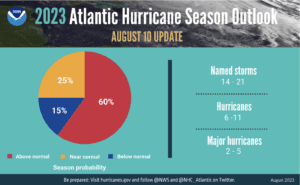After a relatively uneventful Atlantic hurricane season to date, the National Ocean and Atmospheric Administration (NOAA) has upgraded its 2023 forecast through the end of November. This comes just as the first landfalling hurricane of the 2023 season slammed the Florida Gulf Coast.
Scientists at NOAA’s Climate Prediction Center — a division of the National Weather Service — have increased their prediction for the ongoing 2023 Atlantic hurricane season from a near-normal activity level to an above-normal activity level with this update. Forecasters believe current ocean and atmospheric conditions, such as record-warm Atlantic sea surface temperatures, will likely counterbalance the usually limiting atmospheric conditions associated with the ongoing El Nino event.
NOAA forecasters have increased the likelihood of an above-normal Atlantic hurricane season to 60% (increased from the outlook issued in May, which predicted a 30% chance). The likelihood of near-normal activity has decreased to 25%, down from the 40% chances outlined in May’s outlook. This new update gives the Atlantic only a 15% chance of seeing a below-normal season.
NOAA’s update to the 2023 outlook — which covers the entire six-month hurricane season that ends on November 30 — calls for 14-21 named storms (winds of 39 mph or greater), of which six to 11 could become hurricanes (74 mph or greater). Of those, two to five could become major hurricanes (winds of 111 mph or greater). NOAA provides these ranges with a 70% confidence. These updated ranges include storms that have already formed this season.
Notwithstanding the devastating impact on property and human life, hurricanes have proven to substantially impact the truckload freight market, especially the devastating wind-related events in the Southeast. The current flatbed freight market is extremely soft following the ongoing downturn in residential and commercial construction downturn. High-interest rates, supply chain issues, and labor shortages have put the brakes on building activity and flatbed load volume, but as they did in 2017, major hurricanes can alter the market outlook immediately.
The 2017 Atlantic hurricane season was extremely active and devastating. It was also the costliest on record; its damage total was at least $294.92 billion. Most of the U.S. damage was due to hurricanes Harvey, Irma, and Maria.
On August 17, Category 4 Hurricane Harvey devastated parts of Texas and Louisiana. Reaching Category 5 status before weakening after damaging numerous Caribbean islands, Hurricane Irma made landfall on Florida’s Cudjoe Key on September 10. It then weakened to Category 3 status before another landfall in Florida on Marco Island later that day. The system degraded into a remnant low over Alabama and ultimately dissipated on September 13 over Missouri. Hurricane Maria was a deadly Category 5 hurricane that devastated the northeastern Caribbean in September 2017, particularly in the U.S. territory of Puerto Rico, which accounted for 2,975 of the 3,059 deaths. Maria is the deadliest and most costly hurricane to strike Puerto Rico and is the deadliest hurricane in terms of category strength to strike the country of Dominica and the U.S. Virgin Islands territory.
The extensive rebuilding effort in the continental U.S. after Harvey and Irma increased flatbed demand in the Southeast, providing a much-needed boost to the freight market following the 2016 freight recession. Further spikes in flatbed demand were caused by transporting supplies to East Coast ports for use in Puerto Rico. While no one wants a hurricane to make landfall, 2023 may bring late-season damage.
“The main climate factors expected to influence the 2023 Atlantic hurricane activity are the ongoing El Nino and the warm phase of the Atlantic Multi-Decadal Oscillation, including record-warm Atlantic sea surface temperatures,” said Matthew Rosencrans, lead hurricane season forecaster with NOAA’s Climate Prediction Center. “Considering those factors, the updated outlook calls for more activity, so we urge everyone to prepare for the continuing season.”
NOAA urges everyone in vulnerable areas to have a well-thought-out hurricane plan and stay informed through official channels as this season progresses.



